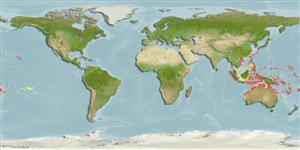Common names from other countries
>
Eupercaria/misc (Various families in series Eupercaria) >
Labridae (Wrasses)
Etymology: Labroides: Greek, labrax, -akos = a fish, Dicentrarchus labrax + Greek, suffix, oides = similar to (Ref. 45335).
More on authors: Randall & Springer.
Environment: milieu / climate zone / depth range / distribution range
Écologie
marin récifal; profondeur 0 - 30 m (Ref. 128797). Tropical; 28°N - 25°S, 94°E - 128°W
Pacific Ocean: Cocos-Keeling Island in the eastern Indian Ocean to the Line and Pitcairn islands, north to the Bonin Islands, south to Rowley Shoals and the Great Barrier Reef.
Taille / Poids / Âge
Maturity: Lm ? range ? - ? cm
Max length : 11.0 cm TL mâle / non sexé; (Ref. 30874)
Description synthétique
Clés d'identification | Morphologie | Morphométrie
Épines dorsales (Total) : 9; Rayons mous dorsaux (Total) : 10 - 12; Épines anales: 3; Rayons mous anaux: 9 - 11. Identified by the mostly yellow head and black spot below the pectoral fin base (Ref. 48636). Scales on lateral line: 28 (+2 past hypural) (Ref. 1602).
Inhabits coral-rich areas of seaward and clear lagoon reefs (Ref. 9710). Occur solitarily or in pairs. Creates 'cleaning ' stations to which fishes come to have crustacean ectoparasites and mucus removed.
Life cycle and mating behavior
Maturities | Reproduction | Spawnings | Egg(s) | Fecundities | Larves
Oviparous, distinct pairing during breeding (Ref. 205).
Randall, J.E., G.R. Allen and R.C. Steene, 1990. Fishes of the Great Barrier Reef and Coral Sea. University of Hawaii Press, Honolulu, Hawaii. 506 p. (Ref. 2334)
Statut dans la liste rouge de l'IUCN (Ref. 130435)
CITES (Ref. 128078)
Not Evaluated
Menace pour l'homme
Harmless
Utilisations par l'homme
Pêcheries: commercial; Aquarium: Commercial
Outils
Articles particuliers
Télécharger en XML
Sources Internet
Estimates based on models
Preferred temperature (Ref.
115969): 25.4 - 29.4, mean 28.4 (based on 1215 cells).
Phylogenetic diversity index (Ref.
82804): PD
50 = 0.5312 [Uniqueness, from 0.5 = low to 2.0 = high].
Bayesian length-weight: a=0.00501 (0.00207 - 0.01214), b=3.15 (2.94 - 3.36), in cm Total Length, based on LWR estimates for this (Sub)family-body shape (Ref.
93245).
Niveau trophique (Ref.
69278): 4.0 ±0.66 se; based on food items.
Résilience (Ref.
120179): Haut, temps minimum de doublement de population inférieur à 15 mois (Preliminary K or Fecundity.).
Fishing Vulnerability (Ref.
59153): Low vulnerability (10 of 100).
